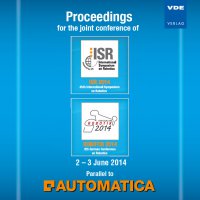An Automatic Industrial Robot Cell Calibration Method
Conference: ISR/Robotik 2014 - 45th International Symposium on Robotics; 8th German Conference on Robotics
06/02/2014 - 06/03/2014 at München, Germany
Proceedings: ISR/Robotik 2014
Pages: 6Language: englishTyp: PDF
Personal VDE Members are entitled to a 10% discount on this title
Authors:
Ge, Jingguo (Robotics R&D, ABB Engineering (Shanghai) Ltd. Shanghai, China)
Gu, Hao; Lu. Qi; Li, Qingwei (Corporate Research Center, ABB (China) Ltd. Shanghai, China)
Abstract:
In robot cell, especially electronic assembly cell, usually a lot of parts are feed with a tray, the tray needs to be pushed in and pulled back frequently, or the tool, need to be changed over after wear(such as the electrode in TIG arc welding) or after exhausted (such as a glue gun). For these cases, the work object coordinate and tool coordinate often change slightly, so they need to be recalibrated. This paper describes an automatic calibration method for work object coordinate and tool coordinate aims at robot cell in electronic industry that needs frequently but slightly changing of trays and tools. Devices used in this method include a displacement sensor, a ball and three fixed intersected planes in robot cell. Three intersected planes on a cubic are used to setup a work object coordinate, to orthogonalize these three planes, this paper proposes a cyclic cross method. To calibrate tool coordinate, using the tip of displacement sensor to touch a fixed ball, Levenberg-Marquardt fitting algorithm is used to fit the ball center and tool offset. All the calibration algorithms are implemented with ABB RAPID language. Experiments are carried out on an ABB IRB140 robot and results show that this method has great stability and high accuracy. The work object calibration accuracy can achieve ±0.03 mm, which is close to the repeat accuracy of this type of robot. The tool coordinate calibration accuracy is about ±0.4 mm because it introduced rotation movement of robot, so the error depends on absolute accuracy of robot. The whole method can run automatically and finish in 15 minutes. It has been tested firstly in lab and then onsite. With this technology, a robot program made for one robot cell can be transferred to another “identical” robot cell.


